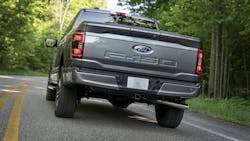Workholding Solutions Have a Grip on Lightweighting
At a Glance:
- Manufacturers prioritize lightweighting as they move to a mix of lighter, more advanced materials for structural parts.
- Historically, automotive manufacturers favored steel for its strength and lower cost relative to other materials, such as carbon fiber, aluminum and magnesium. That’s changing thanks to mixed-materials strategies.
- One of the challenges with changing materials in the manufacturing process is being able to keep up with the most efficient ways to make those parts.
- Innovative super-precision machining and non-deforming workholding solutions can offer some relief.
In the automobile and aircraft industries, the course has been set for some time to develop materials and design methods as a way to reduce fuel economy and reduce emissions.
Lightweighting strategies have been ongoing for internal combustion engines and will continue to be high priority for electric vehicle manufacturers, according to Chris Brown, commercial sales engineer, Forkardt, a manufacturer of custom designed rotating workholding devices for machine tools. Designers in the aerospace and automotive industries have for decades considered lightweighting, or reducing the weight of a product, to be a challenging constraint that’s driven by both cost and performance, he said.
Regardless of the method and targeted variables to switch out heavy metals, such as steel and aluminum, in favor of composite materials, the objective remains tied to optimal design. Over time, initiatives that started with the objective to achieve higher mileage for automobiles, evolved into changes to materials.
“We started seeing automobile bodies change from steel to [using] more plastics,” said Brown, who has been observing the lightweighting trend over the course of his 18-year career with Forkardt. “Your front and rear bumpers used to be made of steel. Now there’s just a steel backbone to what is typically a plastic of some sort. And when you look at the aircraft industry, where they’re trying to make those much more efficient, they’ve also looked at reducing weight.”
A Grip on Workholding
When OEMs run the numbers to determine the best business case for selecting a mix of lighter and advanced materials for structural parts, they realize new materials go hand-in-hand with new equipment and tooling solutions. Tool & die and workholding companies are presented with designs featuring lighter materials as lightweighting becomes more prevalent, noted Brown.
Forkardt, which specializes in manufacturing aluminum die-cast materials and thin-walled components where part deformation is a concern, keeps tabs on evolving demands of automotive and aerospace markets with an eye to catering to challenging applications.
Brown pointed out that newer, flexible thin-walled parts can easily distort under the pressure of normal machining and have a higher risk of bending or deforming in the clamping process.
Grip forces generated from standard or semi-standard workholding products will deform these new lightweight materials.
One of Forkardt’s workholding solutions, a Soft-Touch chuck design, allows clamp fingers to conform to a part’s natural, as-processed contour. Coupled with regulated clamping pressure, the resulting force dynamics actually give rigidity to fragile and delicate parts.
A bladder within the chuck expands to grasp a part by matching a component’s irregular shape, explained Brown. “What that bladder pushes against are a bunch of fingers,” he said. “Once the bladder fills up with hydraulic fluid, those fingers come in and grip the part.”
Although the Soft-Touch technology has been on the market for a long time, Brown contends this type of technology will become even more relevant as lightweighting becomes more prevalent across industries.
Optimize Tooling
Brown is realistic about the current viability of lightweighting for manufacturing applications. Changes in the material mix bring both challenges and opportunities, he said, because manufacturers researching new materials are not only confronted with threats to their margins, but the new mix of materials may also stymie processes whenever lighter, more advanced materials are used for structural parts.
Since competence in lightweighting will be key in future competitiveness, as Brown sees it, that is where workholding choices can pack a punch.
“OEMs will be building more of these custom chucks to reduce the cost to the supplier and machine designers and builders will become more efficient in how they provide solutions,” Brown said. “And if you’re a business that isn’t adapting to address that, your future could be at risk. We’re not going to be making cars that are heavier.”
About the Author

Rehana Begg
Editor-in-Chief, Machine Design
As Machine Design’s content lead, Rehana Begg is tasked with elevating the voice of the design and multi-disciplinary engineer in the face of digital transformation and engineering innovation. Begg has more than 24 years of editorial experience and has spent the past decade in the trenches of industrial manufacturing, focusing on new technologies, manufacturing innovation and business. Her B2B career has taken her from corporate boardrooms to plant floors and underground mining stopes, covering everything from automation & IIoT, robotics, mechanical design and additive manufacturing to plant operations, maintenance, reliability and continuous improvement. Begg holds an MBA, a Master of Journalism degree, and a BA (Hons.) in Political Science. She is committed to lifelong learning and feeds her passion for innovation in publishing, transparent science and clear communication by attending relevant conferences and seminars/workshops.
Follow Rehana Begg via the following social media handles:
X: @rehanabegg
LinkedIn: @rehanabegg and @MachineDesign

